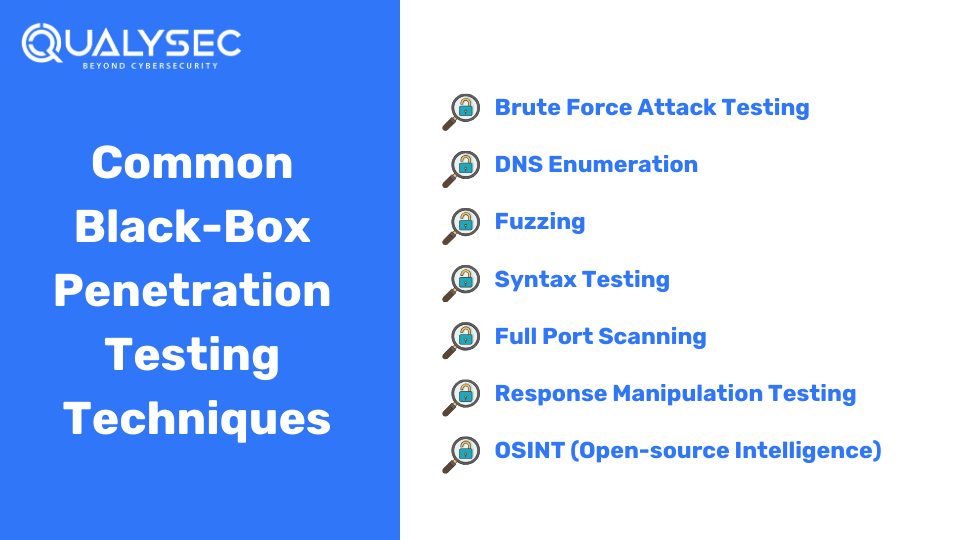© 2024 Qualysec.com Disclaimer Privacy Policy Terms & Conditions

Black box penetration testing is an essential component of any organization’s cyber security strategy, and understanding the foundations of the process is crucial. Professional ethical hackers perform black box penetration testing to detect vulnerabilities in IT systems and networks before attackers do and exploit them. This blog discusses black box penetration testing, reviews every aspect of the process, and demonstrates how it may be utilized in practice.
Black Box Penetration Testing (or pentesting) is a cyber security assessment technique based on simulated cyber-attacks without revealing the system’s inner workings or codebase. Therefore, by mimicking the position of an outsider hacker during the testing process, testers are provided with limited information about the system that is being tested.
Black box penetration determines the level of the security posture of the system and exposes weaknesses that hackers may abuse. Black Box penetration testing uses different tools and approaches to detect flaws in the defense system. Henceforth, the results of the test are crucial to strengthen the overall security defense of the system.
Without prior knowledge of the system’s architecture or internal workings, black box pentest simulates real-world threats, uncovering vulnerabilities that might otherwise go unnoticed. This testing method comprehensively evaluates an organization’s defenses, identifying weak points and potential entryways for malicious actors. Furthermore, by revealing vulnerabilities and assessing security controls, organizations can strengthen their defenses, mitigate risks, and enhance security resilience against cyber threats.
Penetration testing, also called pen testing, is a cybersecurity practice involving simulated cyberattacks to identify security vulnerabilities. The testing can be divided into different types depending on the information level, access provided to the tester, and the technique used. The three main types of penetration testing are:
In black box testing, testers do not have any prior knowledge about the target system’s infrastructure, architecture, or source code. They act as an exterior hacker and use publicly available information. This type of testing manifests actual attacks and measures how the system reacts under external damage.
White box testing, also known as precise box testing or glass box testing, is the opposite of black box testing. The testers are provided with detailed information about the target system, such as its source code, network diagrams, and infrastructure details. Due to this, testers will be able to discover flaws more precisely and correctly. White box testing is beneficial for measuring the security status of a company from an insider’s view.
Gray box testing is a mixture of black and white box testing. In such cases, the testers have only limited information about the system, such as the system architecture or network diagram, but no access to the source code or internal details. Gray box testing simulates an attacker’s viewpoint with partial knowledge or access. Hence, it can provide a practical standpoint by which realism and detail in security assessment can be optimized.
Some of the basic techniques for black-box penetration testing are mentioned below. Let’s delve into each briefly:

This involves systematically trying out all possible combinations of usernames/passwords or encryption keys until one is guessed correctly. It is relatively efficient against weak passwords and vulnerabilities created by weak authentication mechanisms.
This involves collecting information about the target’s DNS servers, including host names, IP addresses, mail servers, etc. Such data will increase the chance of a successful attack.
Fuzzing is a technique in which tools automatically input random or unusual data into a system to expose the vulnerability, particularly in software interfaces, APIs, or protocols.
This consists of application/system testing using input with specific syntax patterns to check for weaknesses like SQL injection, XSS, etc.
Scanning all ports of the target system is the tool to identify the open ports and services running on them. It makes it possible to comprehend the attack surface and potential entry points.
With this methodology, a tester would try to affect and manipulate the responses from the given system to see how it behaves in different conditions. Through this, we can indicate possible vulnerabilities such as input validation, handling of errors, etc.
This involves investigating publicly available data about the objective, including employee names, email addresses, software versions, etc. It can help determine the target’s infrastructure and possible attack vectors.
The checklist for black box penetration testing is as follows:
Before engaging in any Penetration test, conducting a detailed investigation of the target system or network is vital to get as much information as possible. This involves targeting possible vulnerabilities, figuring out the infrastructure, exposing threats, and defining the network.
This implies the search for typical flaws like system configuration problems, weak passwords, and known software flaws. It is crucial to focus on vulnerabilities with high impact and high likelihood of exploitation in the most efficient order.
Following the penetration testing, provide an informative and brief report, which includes the found vulnerabilities and their possible impact, as well as the suggested mitigation measures. Furthermore, it aims to show the client how to solve and handle the issues identified as security threats. It guarantees that the client is provided with practical measures to increase security positioning and prevent future hazards.
Want to see what a real-time black box penetration testing report looks like? Download the sample report now!
Here are the typical steps involved in conducting black-box penetration testing:
Since the organization doesn’t provide the testers with any knowledge of the environment being tested, they gather as much information as possible from publicly available web pages.
Here the testers define the scope and strategies of the pentest. They plan which vulnerabilities to check and what technology to use.
In this step, the testers use automated tools to scan known vulnerabilities. Since the tools follow a specific script, it is a quick but in-comprehensive process of finding vulnerabilities.
Here the testers use human expertise to manually test the given software for hidden vulnerabilities. it is the most comprehensive way to find maximum vulnerabilities present in a software or network.
The pen testers now generate a comprehensive report that is easy to read for developers, outlining every vulnerability they have found, their level of impact, and remediation steps.
At this point, the developers use the pentest report to fix the vulnerabilities. If needed, the testers will help them locate the vulnerabilities over consultation calls.
The program is re-tested in the next phase to ensure that all the vulnerabilities are fixed and no new weaknesses have been found.
Finally, the pen testers provide security certificates, which confirms that the organization has conducted black-box penetration testing.
Would you like to protect your website and online apps against cyberattacks? Connect to obtain our black box penetration services to discover and fix flaws in your web apps immediately. Click below to schedule a call!

Talk to our Cybersecurity Expert to discuss your specific needs and how we can help your business.
| Tools | Descriptions |
| Burp Suite | It is the most powerful method for implementing web application security tests. It has different parts, such as a proxy, scanner, intruder, repeater, sequencer, and decoder, that help spot weak spots in web apps. |
| OpenSSL | As an open-source implementation of the SSL and TLS protocols, OpenSSL provides the necessary command-line tools for cryptographic operations. Further, these tools are primarily used in penetration testing for certificate management, encryption, decryption, and digital signatures. |
| Metasploit | Metasploit is a popular penetration testing framework that gathers information about security vulnerabilities, making penetration testing and IDS signature development easier. Additionally, it consists of tools, payloads, and exploits that security specialists use to test different systems for weaknesses. |
Black box penetration testing is critical to upgrading an organization’s cybersecurity defenses. This methodology identifies flaws by creating real-world attacks that mirror the perspective of external hackers. Furthermore, organizations may improve their security posture and resistance against cyber threats by using a systematic strategy that includes reconnaissance, vulnerability assessment, and repair assistance. Black box pen testing uses manual approaches and automated vulnerability scanning tools such as the Burp Suite, OpenSSL, and Metasploit. Hence, integrating black box pen testing is a requirement and a strategy for safeguarding sensitive data and digital assets.
A. In penetration testing, a black-box approach is where testers have no information about the system to be investigated. Therefore, this emulates the outsider’s point of view, enabling simple and transparent examination and detection of weaknesses.
A. Whitebox penetration testing is where the testers get access to the internal architecture and code of the computer network system. Whereas, Black box penetration testing mirrors the outsider’s viewpoint with no previous knowledge and checks the security of an external outsider. Both techniques allow the evaluation and detection of system vulnerabilities.
A. Primarily, cybersecurity experts or ethical hackers perform black box penetration testing. It involves evaluating a system’s security without understanding its internal code. Additionally, it focuses on inputs and outputs, mimicking user interactions to detect flaws and guarantee that the software fits needs and standards.





Plot No:687, Near Basudev Wood Road,
Saheed Nagar, Odisha, India, 751007
No: 72, OJone India, Service Rd, LRDE Layout, Doddanekundi, India,560037
© 2024 Qualysec.com Disclaimer Privacy Policy Terms & Conditions


No: 72, OJone India, Service Rd, LRDE Layout, Doddanekundi, India,560037
© 2024 Qualysec.com Disclaimer Privacy Policy Terms & Conditions